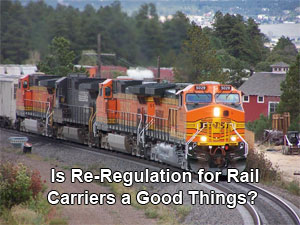Calls for Re-Regulation
 The railroads were de-regulated by the federal Stagger’s Act of 1980, which directed the Interstate Commerce Commission to deregulate the rail industry. The result, as with similar moves in the trucking sector, removed the government from a role in setting freight rates.
The railroads were de-regulated by the federal Stagger’s Act of 1980, which directed the Interstate Commerce Commission to deregulate the rail industry. The result, as with similar moves in the trucking sector, removed the government from a role in setting freight rates.
The rail carriers’ position was further strengthened in 1999, when the Surface Transportation Board (the successor agency to the Interstate Commerce Commission) ruled that the rail carriers did not have to break up pricing into individual segments on complex routes that required hand-offs between carriers. This was key because many routes into the rail network are monopolies for a single carrier. Shippers wanted the flexibility to leverage competition on the longer haul segments of the move that were served by two or more carriers, but the STB instead ruled the monopoly carrier on the so-called “bottleneck” segment could price the entire move, based on rules for sharing of the revenue across all the carriers involved. That decision was later upheld in federal court, and has been rued by rail shippers ever since.
Now, there are calls for re-regulation from several quarters.
For example, an industry group called Consumer United for Rail Equity (Cure) that includes member companies from such industries as utilities, chemicals and general manufacturing is calling for re-regulation on rail pricing on a number of fronts.
In particular, CURE is pushing for passage of the Railroad Antitrust Enforcement Act, a bill first proposed in 2007 by Wisconsin representative Tammy Baldwin, which would repeal most antitrust exemptions for rail carriers, “override” some claimed anti-competitive rulings of the STB, and allow stronger rights for shippers to challenge rail carrier rates, among other provisions. A similar bill has been proposed by the Senate. While neither bill has gained much traction since they were first proposed, some believe the efforts are gaining momentum.
In December, the anti-trust division of the American Bar Association gave its endorsement of the bill, adding important support to the effort.
Many observers believe a more heavily Democratic Congress and new Democratic president will be more sympathetic to the bill than the last group in Washington.
The incoming chairman of the Senate Commerce Committee, John D. Rockefeller of the coal producing state of West Virginia, for example, recently said that “achieving a competitive balance” between the interests of the railroads and their customers would be “high on the Senator’s agenda.
The issue is especially important to the so-called “captive” rail shippers, who have access to only one rail provider. Estimates are that as many as one-third of all rail shippers fall into the captive category. Combined with the “bottleneck” ruling, it means rail carriers frequently are not competing with themselves for a shippers business, but with trucking as an alternative mode. This gives them tremendous pricing power.
The rail industry defends itself by noting these relatively good times are a very recent phenomenon after decades of financial woes. A recent analysis by the STB found that most of the recent rate hikes were the result not of monopolistic power, but rather rising costs and rapidly slowing productivity gains (a finding many dispute).
Others note the need for substantial build-out of the US rail network over the next 20 years, and wonder how that will happen if changes sharply reduce carrier profitability and cash flow.
Regardless, it seems likely that some type of legislative action will happen in the next two years, as shippers struggling with shaky business conditions increase the pressure on Washington to help them reduce rail costs that were an irritant, but not too much of an issue in flusher times.
Do you believe we need to return to tighter regulation of the railroads? In what areas? Should Washington again set prices? Let us know your thoughts at the Feedback button below.